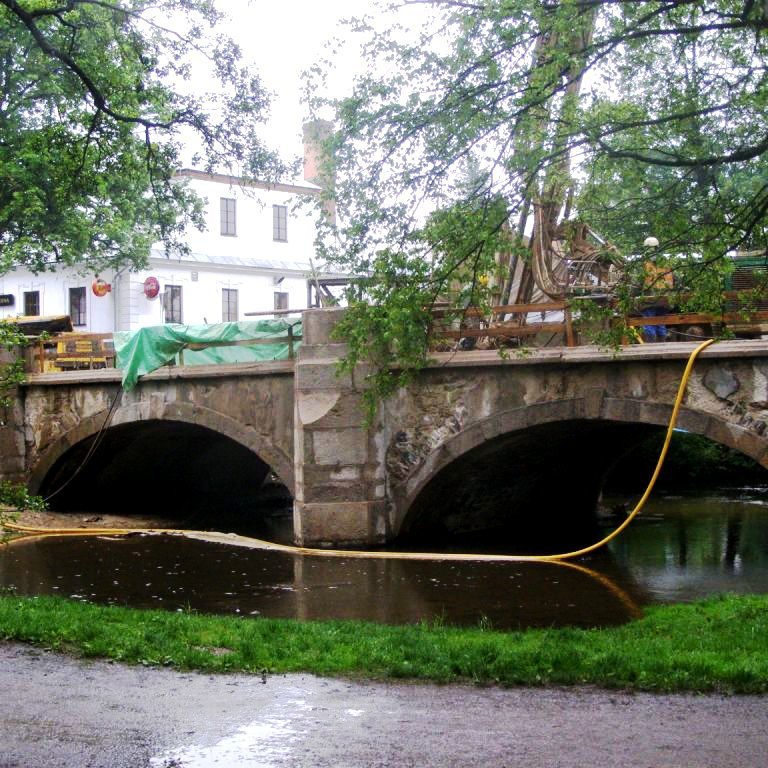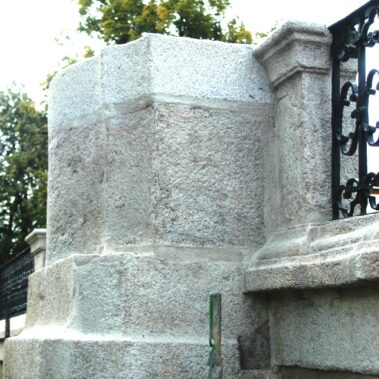Baroque Bridge in Žďár nad Sázavou, Czech Republic

| Address: | Most přes Stržský potok, 591 01 Žďár nad Sázavou |
|---|---|
| Description of work: | Dismantling of the Baroque bridge
Height adjustment of the bridge Restoration of the Baroque monument |
| Contractor: | GEMA ART GROUP a.s. |
| Investor: | Stavba mostů – Bridge Constructions Praha, a.s. |
| Implementation: | 2009 |
The history of the stone bridge in Žďár nad Sázavou has a connection to the local Cistercian Order monastery. The order came to this area from their Western Bohemian monastery in Nepomuk (which was then called Pomuk) in 1252. The original Gothic structure underwent numerous architectural alterations and acquired its Baroque appearance during the time of Abbot Václav Vejmluva at the beginning of the 18th century. The important Czech architect of Italian origin, Jan Blažej Santini, took part in the design of the Baroque makeover, which continued during the time of the subsequent Abbot Bernard Hennet (1699-1770), who commissioned in 1751 the building of a new Baroque bridge. In the years between 1761 and 1766 statues of eight saints, the work of an unknown artist, were placed on the bridge. The statues stand on substantial pedestals and have chronograms with descriptions of the saints. The sculptural ornamentation was inspired by the statues on Charles Bridge in Prague and consists of statues of four saints connected to the history of the Czech Lands – St Cyril and St Methodius, St Adalbert and St John of Nepomuk and other four saints, prominent in Christian history – the Apostle St Paul, St Nicholas, St Benedict and St Bernard of Cairvaux, the spiritual leader of the Cistercian Order. The original statues remained on the bridge until May 2009, when they were dismantled for the purpose of restoration and replaced by identical copies. The intention is to install the originals in the Lower Cemetery in Žďár nad Sázavou.
During its long history the bridge had undergone several building alterations, the most significant of which was the underpinning of its arches by reinforced concrete panels. The last reconstruction, with the participation of GEMA ART GROUP a.s., took place in 2009.
The work involved in the project included the restoration of this Baroque monument as well as the technically demanding task of the height adjustment of the bridge required for the elevation of the carriageway. Prior to any construction work the bridge had to be surveyed using photogrammetric-geodetic method and detailed photo documentation and cataloguing of individual stone parts, undertaken in order to carry out the dismantling of the bridge structure. For restoration purposes petrological surveys and sampling of stone for salinity levels were also carried out. All tasks were consulted with representatives of the Heritage Institute and the investor. The aim of the restoration was to respect the natural ageing process and the surface finish of all the new parts was harmonized with their older surroundings.
Height adjustment of the bridge:
Following detailed photo documentation, the upper part of the bridge was taken apart down to the level of the newly elevated road surface. The height adjustment of the bridge was effected by insertion of a granite stone belt, placed on new mortar on the row of stone masonry beneath the belt. The bedding mortar was enriched with additions of oil, a substance suitable for the establishment of a porous masonry system. The masonry bearing the belt was prior to its installation statically secured and repointed using hydraulic pointing mortar. Due to the strength required for the structure, lime mortar was not suitable.
The inserted belt was manufactured from granite obtained from the Panská Dubenka quarry, which compared best with the original stone from Ořechovec near Dolní Město. The granite belt was shaped mechanically. Because of their construction, the bridge arches could not be dismantled and replaced by a granite belt and were instead repaired using stone slabs.
The original manner of anchoring the stone blocks was respected during the installation of the slabs. The structure was further strengthened by steel anchor points. Corroded parts of previous repairs were removed. All assembly work was carried out in precise accordance with photo documentation and parameters of the photogrammetric survey.
Restoration of the architectural elements of the bridge :
The bridge can be dated back to the year 1751. The eight statues of the saints were not part of the restoration remit.
The bridge showed significant signs of structural stability disturbance. Old unsuitable pointing with cement mortar was in places cracked or missing. Many stone architectural elements had already been replaced during past building work. There were sand stone inserts, granite parts from various locations and cement plugs. The movement of the bridge structure had caused significant cracks in the granite. On the lower parts and on the vaulting were occurrences of salt bloom. The fabric of the stone parts was further damaged by reinforcing cramp irons, which were considerably corroded. Penetration of iron oxides into the stone caused its change of colour. Plaster applied to the bridge during previous repairs had in many places fallen off.
After the disassembly the individual architectural parts were rid of cement inserts and unsuitable repair material. All corroded cramp irons and other anchorage parts were removed.
The surface of the granite was cleaned of dust and other contamination using pressurized water and gentle detergent. Any secondary coatings were removed with aid of ammonium hydrogen carbonate wraps. Unwanted asphalt deposits were eliminated mechanically and by sand blasting. Surface algae was removed using a special biocide solution.
Cracks were in-filled, sealed with epoxide resin and consolidated with organosilicate fixative. Missing parts or larger defects were mended using epoxide and a crushed granite mixture. Colour retouching by a special iron oxide solution was also carried out. Hydrophobic agent was applied to exposed areas and to horizontal pointing.
To conclude, the surface of the new stone was bush hammered and sand blasted to blend with the appearance of the original parts.



















